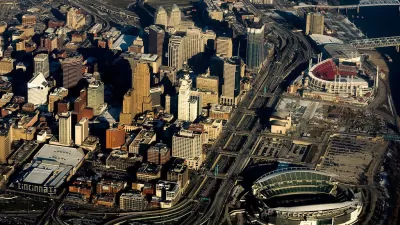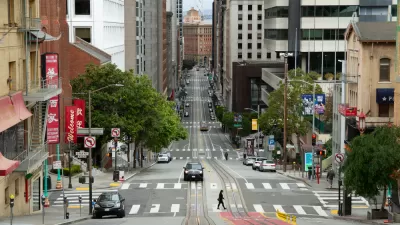Central districts benefit from diversity, but a century of disinvestment and exodus has put many in a precarious position.

The downtown business districts of many American cities, write Emily Badger and Quoctrung Bui in the New York Times, "were created through subtraction." The office buildings we think of as the core of these districts were all that remained after residents, department stores, small retailers, and entertainment venues fled the central city. This "precarious urban monoculture" "was already susceptible to shocks and recessions before the pandemic."
Now, with offices emptier than ever and many remote workers unwilling to return, the future of the central business district has become an urgent question. "Downtowns, like investment portfolios, are more sustainable when they’re diverse. The past year has made that plainly clear in places like Midtown Manhattan, where property tax assessments, transit ridership and small-business revenue fell particularly far during the pandemic."
Yet despite efforts to rebrand urban downtowns as complete neighborhoods suitable for living, working, and playing in, "a century of history" has left many of them hollowed out and dependent on office buildings for their tax base. Cities that have diversified, like Austin, faced less severe economic losses during the pandemic. "The lesson that downtowns need more than offices is 'not just true in this post-Covid world,' said Kourtny Garrett, the head of Downtown Dallas, Inc. 'For us in Dallas, that’s been true since the big crash in the ’80s.'"
FULL STORY: The Downtown Office District Was Vulnerable. Even Before Covid.

Planetizen Federal Action Tracker
A weekly monitor of how Trump’s orders and actions are impacting planners and planning in America.

Maui's Vacation Rental Debate Turns Ugly
Verbal attacks, misinformation campaigns and fistfights plague a high-stakes debate to convert thousands of vacation rentals into long-term housing.

San Francisco Suspends Traffic Calming Amidst Record Deaths
Citing “a challenging fiscal landscape,” the city will cease the program on the heels of 42 traffic deaths, including 24 pedestrians.

Amtrak Rolls Out New Orleans to Alabama “Mardi Gras” Train
The new service will operate morning and evening departures between Mobile and New Orleans.

The Subversive Car-Free Guide to Trump's Great American Road Trip
Car-free ways to access Chicagoland’s best tourist attractions.

San Antonio and Austin are Fusing Into one Massive Megaregion
The region spanning the two central Texas cities is growing fast, posing challenges for local infrastructure and water supplies.
Urban Design for Planners 1: Software Tools
This six-course series explores essential urban design concepts using open source software and equips planners with the tools they need to participate fully in the urban design process.
Planning for Universal Design
Learn the tools for implementing Universal Design in planning regulations.
Heyer Gruel & Associates PA
JM Goldson LLC
Custer County Colorado
City of Camden Redevelopment Agency
City of Astoria
Transportation Research & Education Center (TREC) at Portland State University
Jefferson Parish Government
Camden Redevelopment Agency
City of Claremont




























